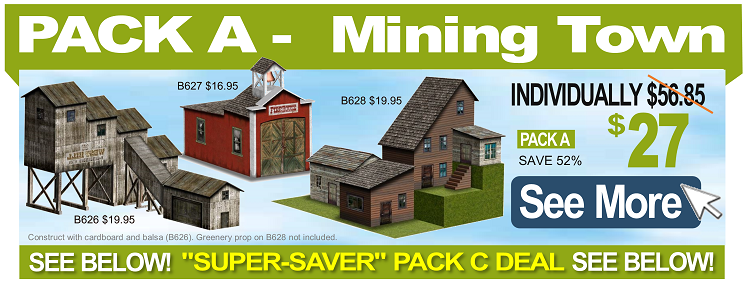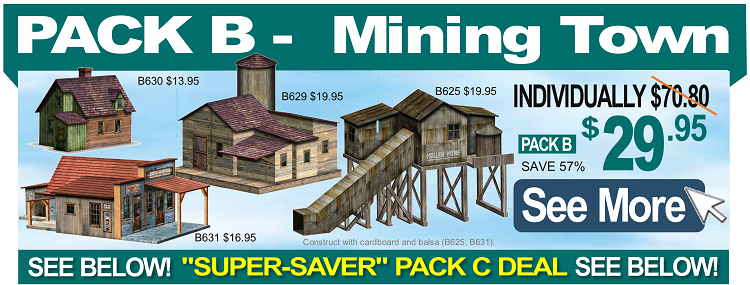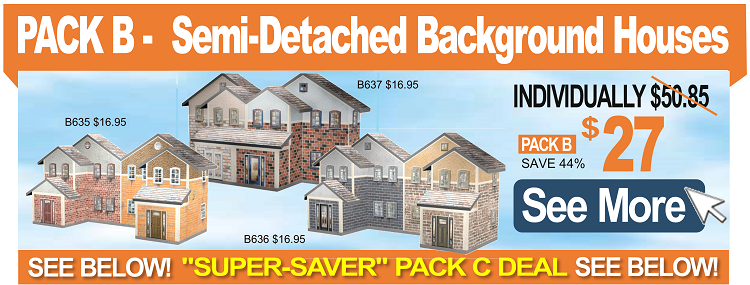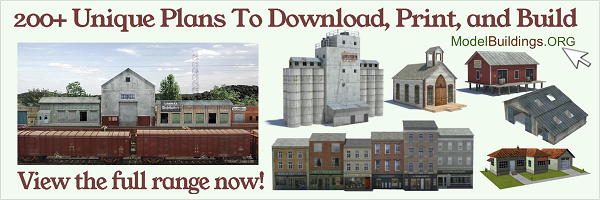Evidence of Habitation Can Make Model Railroad Scenery Look Real And Bring The Scene To Life – But How?
© Copyright https://newmodelbuildings.nexasoftsolutions.net All rights reserved.
What does every human community have in common? Trash. A goodly amount of it, too. Humans discard things by the ton, and unless you are modeling a pristine natural environment, when you add a community or some other area humans are to be found, don’t forget the trash. There are almost as many ways to add trash as there are common items around your house. Small blocks of wood can be turned into crates. Resin castings of barrels and tires can be purchased from most hobby outlets if you need something specialized. Piles of dirt can be created with a mound of newspapers, plaster cloth, and some actual dirt. Round plastic coffee stirrers are perfect for stacks of pipe or individual discards. Twine or string can be dyed an appropriate color for discarded lengths of rope.
Parts from discarded rolling stock can decorate a yard scene or repair track. Old ties from strips of tongue depressor or wooden coffee stirrers, cut to length and stained with appropriate colored washes can lay around small trackside buildings. Don’t forget to drop square shaped bits of brown paper into road ditches occasionally to simulate discarded cardboard boxes. Cable spools can be made from dowels and shirt cardboard ends wound with small lengths of plastic insulated wire.
Take a tour of a nearby industrial area and bring your camera or smart phone. Take lots of photographs, then go through your kitchen and garage and look for small bits that look like the objects in your photos. Look for the shape rather than the color, you can always paint to suit.
Be sure to glue your trash down, though. Otherwise you might end up with model trash being real trash on the layout room floor!
Using Paints and Washes To Create Scenery Realism
Paints useful to model railroaders come in five basic types: Enamel, Acrylic, Lacquer, Polycarbonate and Latex. The easiest paints to work with are Acrylics and Latex because they are water soluble and clean up easily leaving very little mess. The more familiar model paints for rolling stock and plastic items are Enamels and Lacquers and require a special thinner product to clean up and remove spills. Polycarbonates are usually found in the form of spray cans or airbrush products and sometimes need surface preparation besides cleaning to adhere well.
Washes are made from paint plus whatever thinner is appropriate to the paint type. Washes can be of nearly any proportion, but 4:1 or 5:1 thinner to paint is typical. A rule of thumb is that the thinner the wash, the easier it is to control the effect. It’s best to use several very thin coats of wash than one thicker coat.
Paints in general are used for base colors of any object. Rolling stock, buildings, scenery base, all take a decent base coat to start from. Subtle shading, particularly weathering, is best done with washes. Because a wash is by definition a very thin coat, it will tend to run according to gravity and well simulates rust streaks, water stains, or oil spills.
A variety of brushes and containers are necessary with paints and washes. It’s not a good idea to mix different types of paint in the same container or brush, no matter how clean you think you might have gotten it. It would be wise to have a supply of disposable mixing containers for creating your washes from the base paints.
Washes can also be applied via airbrush, so if you use one you’ll also want to have the appropriate type of clearer for the paint you are using.
Inks and dyes can also be pressed into service as washes and scenic tinting. Clothing dyes can be added to plaster mixes to pre-color features, and a 50/50 mixture of India ink and alcohol makes a black/grey wash that is perfect for rock face shadows or just grimy areas. The same tools you use for painting can be used for inks and dyes. Inks can be found in your art store department that has supplies for calligraphy.
What do I do with all of this?
There are about as many storage solutions as there are modelers. If you are lucky to have a permanent workbench, many of these products can be placed on small shelves made of 1×2” pine stock. If you are forced to use the kitchen table for your products, very inexpensive plastic storage containers come in a bewildering array of sizes and configurations. A trip to your big box store like Wal-Mart or K-Mart will undoubtedly give you an opportunity to find the perfect storage solution for your needs. One of the best is a series of stackable plastic drawers with a roller base. This unit is exceptionally portable and conveniently separates your materials by type and use, with one or more drawers allocated to your tool kit if you like.
Miscellany
This piece has just scratched the surface of materials and tools that can be used for creating model railroad scenery. One of the best things about this hobby is the easy and economy of experimentation. None of the materials or tools described above is hugely expensive. Most can be obtained for about the price of a good latte.
Many tools you will find useful started out life with other purposes. Bamboo barbeque skewers, for example, typically have a rather sharp point on one end that can be used for sculpting, holding, drilling, moving, supporting, and as construction materials themselves for building wall bracing, scale fence posts, tree trunks, and many others. Yet, you can find them just about anywhere for a few pennies, and nothing says you can’t recycle the ones you have already used for your barbeque get-togethers! A trip through the dishwasher will get them ready for your tool kit or building materials stash.
It’s up to you, go build something!












